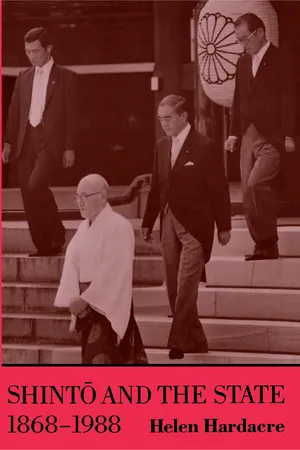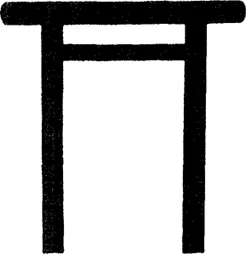In addition to the periodization to be introduced immediately below, running through the entire modern history of Shintō is a thematic issue: Is Shintō properly considered a religion? The early Meiji period was characterized by a rapid influx of Western culture, and among the many new ideas were those dealing with religion. Western, especially Protestant, ideas about religion were absorbed by Japanese intellectuals, but, for the reasons examined in the introduction, they did not produce immediate changes in popular religious life, nor were they widely accepted by shrine priests, many of whom came to believe that Shintō was not a religion but a suprareligious entity. This clash between indigenous and Western notions of religion has provided one focus for debate about Shintō down to the present.
CHRONOLOGICAL OVERVIEW
Several periods in the relation between Shintō and the state can be demarcated for the years 1868 to 1988. Each is characterized by a distinctive attitude of the state toward Shintō, of the Shintō priesthood toward the state, and a particular mode of involvement of the populace and of popular religious movements in Shintō.
1868–1880: Experimentation and Disillusion. The years 1868 to roughly 1880 were characterized by state experimentation with Shintō. Beginning in 1868, the state unceremoniously dropped its former patronage of Buddhism and turned a blind eye when Shintō priests used the occasion to pillage Buddhist temples. At the same time, as part of the Great Promulgation Campaign, state officials wrote doctrine and empowered a bureaucracy headed by Shintō priests to promulgate it and to create accompanying ritual appropriating the symbols, vestments, and rituals of the shrines. When the campaign proved unable to unite the populace in support of a unified creed, however, Shintō bureaucrats fell from favor, and state support, as measured by bureaucratic rank of priests in government service or by monetary grants to shrines, fell sharply.
In the heyday of the campaign, Shintō priests briefly occupied high bureaucratic office and began efforts to overcome the fragmentation and lack of unity that had characterized their history before the Meiji Restoration. The priesthood developed a conviction, still prevalent at the end of the twentieth century, that Shintō was a nonreligious or suprareligious entity with the political function of establishing the spiritual unity of the populace. A component of this attitude was a scornful, elitist view of popular religious life and a conception of themselves as teachers of the populace through ritual, rather than as religious leaders with a pastoral role.
Leaders of many popular religious movements were drawn into the state’s attempt to create a religion out of Shintō through their participation in the Great Promulgation Campaign, with the result that these movements traded their independence and autonomy for the prestige of a connection with the state. This habit became ingrained in many religious movements. Popular religious life—with the exception of the new movements—began to incorporate a national, unified ritual calendar revolving around newly created imperial ritual superimposed upon preexisting local festival calendars. This acceptance was, however, spotty and not fully achieved until perhaps 1900.
1880–1905: Declining State Support. The years 1880 to 1905 represented a low in Shintō’s relation to the state. The bureaucratic offices governing Shintō affairs were ranked lower than in the preceding period. The trend in financial support for the shrines from public funds was to assign ever greater responsibility to local parishes.
This tendency was alarming to the priesthood. Priests understood that if they had to answer to local supporters they would be required to provide such religious services as rites of healing and blessing, as well as funerals, while they were concerned to preserve for themselves a distinctly non-religious status affiliated in some way with the state. The priesthood during this period saw itself an an embattled minority, misunderstood by government and seeking to reinstate the positions of prestige enjoyed briefly in the preceding period.
Nevertheless, during these years many important shrines were constructed and linked in a national hierarchy. The cult of the war dead was begun in earnest, and the populace was drawn into the cult and into shrine life generally by conscription and by an alliance at the local level between the educational system and shrine priests. Popular religious movements remained supporters of Shintō for the most part.
1905–1930: Expansion and Increased Influence. Much of the expansion of relations between Shintō and the state that took place from the end of the Russo-Japanese War to 1945 had been set in motion much earlier and represented simply a hardening or universalization of earlier policy. For example, Shintō mythology had long been used to explain the origins of the imperial house, but the idea of the imperium’s divine origins received new support in this period, and stricter sanctions were applied to anyone who denied it.
The Russo-Japanese War marked the beginning of many social policies, such as the shrine merger program, designed to increase social control more generally. The war, the annexation of Korea (1910), and the colonization of Manchuria produced a heightened mood of patriotism that the priesthood enthusiastically supported. Shrines and their priests were expected to serve the nation in fostering patriotism, and the state proved willing to pay for their services. From around 1910, a program for the training of Shintō priests was underwritten by the state, and its appropriations increased steadily. National budgetary appropriations for shrines rose in absolute terms, though their share of the total annual budget fluctuated considerably (see Table 1).
The priesthood increased its influence in public life during this period through an increased presence in the educational system. Priests were more numerous and better trained, thanks largely to the expanded program of government support. Graduates of Shintō schools such as Kokugakuin University and Kōgakkan University, as well as those holding even a second-grade rank as a priest, were automatically qualified, without further training at normal school, to teach in the public schools, which many did to supplement their meager income as priests. Priests were a great asset in universalizing such practices as formal veneration of the imperial portrait and the Imperial Rescript on Education, as well as periodic visits to shrines by school pupils for labor or formal worship.
Another source of the priesthood’s increasing strength was the creation of a national organization and prefectural branches. The national organization was created in 1900, and by the end of this period it was fully operational. It was supported by branches in every prefecture and made its activities known by a national publication.
1. Government Support for Shrines as Percentage of Total Annual National Budget, 1902—1944 (in yen)
| | Total Budget | Shrine Payments | Percent |
| 1902 | 249,596,131 | 1,071,727 | 0.43 |
| 1907 | 602,400,959 | 510,432 | 0.08 |
| 1912 | 593,596,444 | 358,012 | 0.06 |
| 1917 | 735,024,251 | 877,063 | 0.11 |
| 1922 | 1,429,689,621 | 4,191,009 | 0.29 |
| 1927 | 1,765,723,000a | 1,774,000 | 0.10 |
| 1932 | 1,95 0,141,000 | 1,373,000 | 0.07 |
| 1937 | 2,709,157,000 | 2,297,000 | 0.08 |
| 1942 | 8,276,476,000 | 2,081,000 | 0.02 |
| 1943 | 14,45 9,908,000 | 6,63 3,000 | 0.05 |
| 1944 | 20,173,076,000 | 1,331,000 | 0.01 |
SOURCES: Meiji Taishō zaiseishi (Tokyo: Keizai ōraisha, 1956), Vol. 4; Diamond Keizai tōkei nenkan (Tokyo: Diamondsha, 1939); Tōyō keizai nenkan (Tokyo: Tōyō Keizai shinpōsha, 1926); Naikaku tōkei kyoku, Nihon teikoku tōkei nenkan, 59 vols. (Tokyo: Naimushō, 1882–1940).
Figures from 1927 to 1944 only available in thousands of yen.
In this era, popular religious life became profoundly influenced by the state’s relation with Shintō. The Russo-Japanese War produced many apotheosized “glorious war dead,” and the death of so many in war, followed by their public worship, both at the Yasukuni Shrine and in its prefectural branches, the Nation-Protecting Shrines, brought state-sponsored shrine rites into popular consciousness in a new and deeper way (see Table 2). Observance of shrine rites began to take on a semiobligatory character, and local administrations routinely assessed residents for shrine support.
Popular religious life was also influenced by state intimidation, which itself utilized Shintō elements. Most striking was the suppression of the rapidly growing independent sect, Ōmotokyō, in 1921, when many of its leaders were jailed. Other religious movements were suppressed on charges of lèse majesté if their doctrines were deemed vulgar or somehow slighting to the orthodox view of Shintō mythology.1
1930–1945: Maximized Influence. The years 1930 to 1945 saw a major expansion of shrine administration, culminating in the establishment of the Board of Rites (Jingiin) in 1940, to the gratification of all priests. Appropriations for shrines and priests’ training continued at high levels. Priests continued to occupy positions of prestige in local administrations and in the educational system. These trends represented the expansion and continuation of trends established earlier.
2. Souls Enshrined at Yasukuni, by Wars or Military Engagement
| Meiji Restoration | 7,751 | World War I and | |
| Seinan War | 6,971 | Siberian Invasion | 4,850 |
| Sino-Japanese War | 13,619 | Saishin Incident | 185 |
| Taiwan Annexation | 1,130 | Manchurian | |
| Hokushin Incident | 1,256 | Incident | 17,161 |
| Russo-Japanese War and | | War with China | 188,196 |
| Korean Annexation | 88,429 | World War II | 2,123,651 |
| | | TOTAL | 2,453,199 |
SOURCE: Ōe Shinobu, Yasukuni Jinja (Tokyo: Iwanami shoten, 1984), 16–17.
Shintō’s sphere of influence widened during this period less through any new exertion of the state on its behalf or through new initiatives on the part of the priesthood than as a result of an increasingly closed political culture. Dissent of any kind was suppressed, and political opposition of any kind was so intimidated that those players left in the ring, including the priesthood, could operate with great freedom and without fear of contradiction. In 1932, for example, national outrage followed when Christian students from Sophia University refused to pay tribute at the Yasukuni Shrine. Their refusal to bow before the national shrine for the war dead confirmed suspicions that Christians were unpatriotic and Christianity incompatible with Japanese sensibilities.
During this period the influence of Shintō upon popular religious life increased as more households enshrined talismans of the Ise Shrines (see Table 3), more school trips to the Ise Shrines and other shrines were carried out, and as the general populace traveled to Ise on pilgrimage by the millions (see Table 4). Suppression of popular religious movements continued, most spectacularly in the destruction of Ōmotokyō’s headquarters in 1935. In 1937 the religion Hitonomichi was disbanded by state order on charges of lèse majesté. In 1941 a branch of the Nichiren sect of Buddhism was suppressed for its calligraphic mandala, used as an object of worship, in which Buddhist figures were ranked higher than Shintō divinities. In 19...

